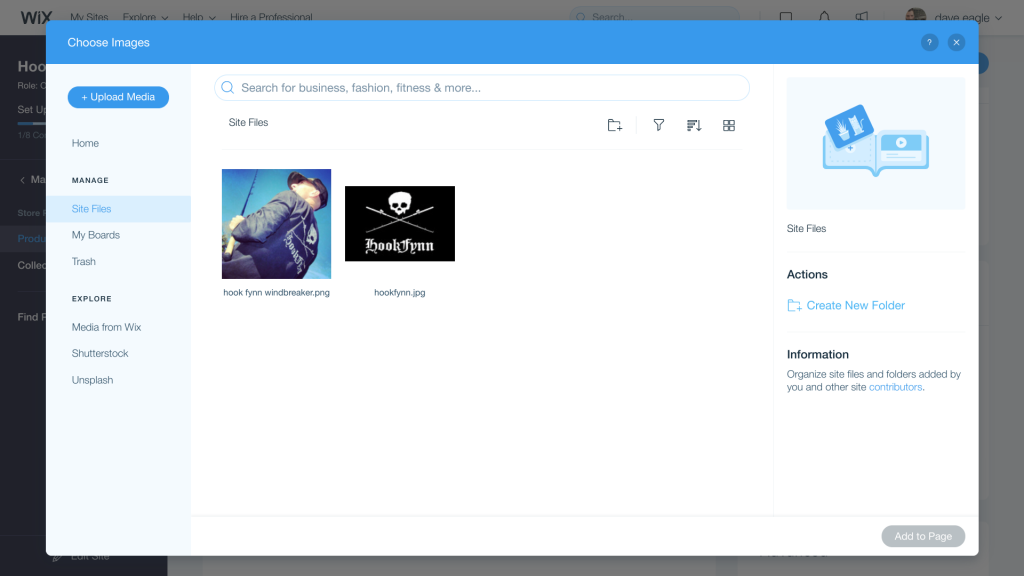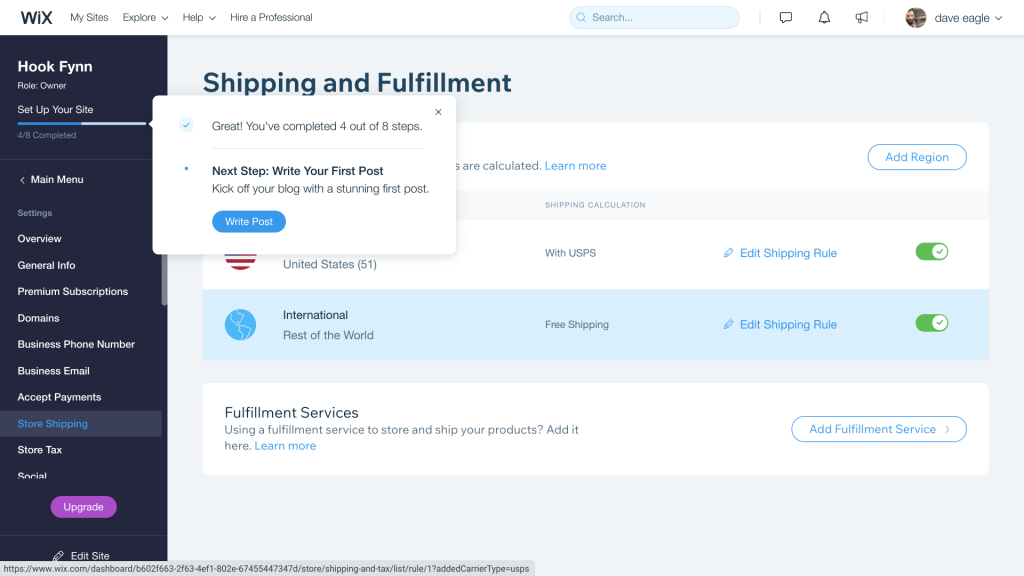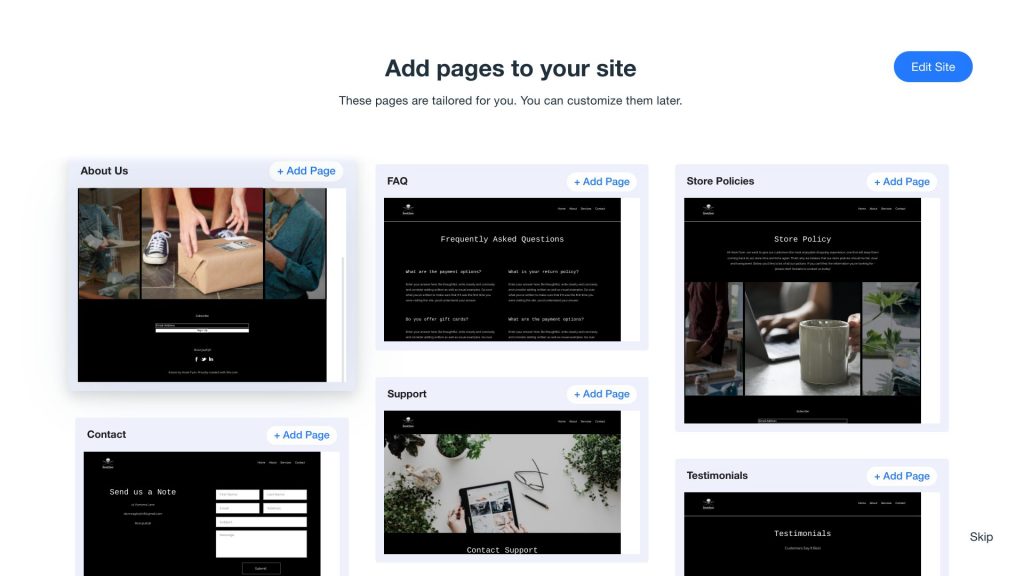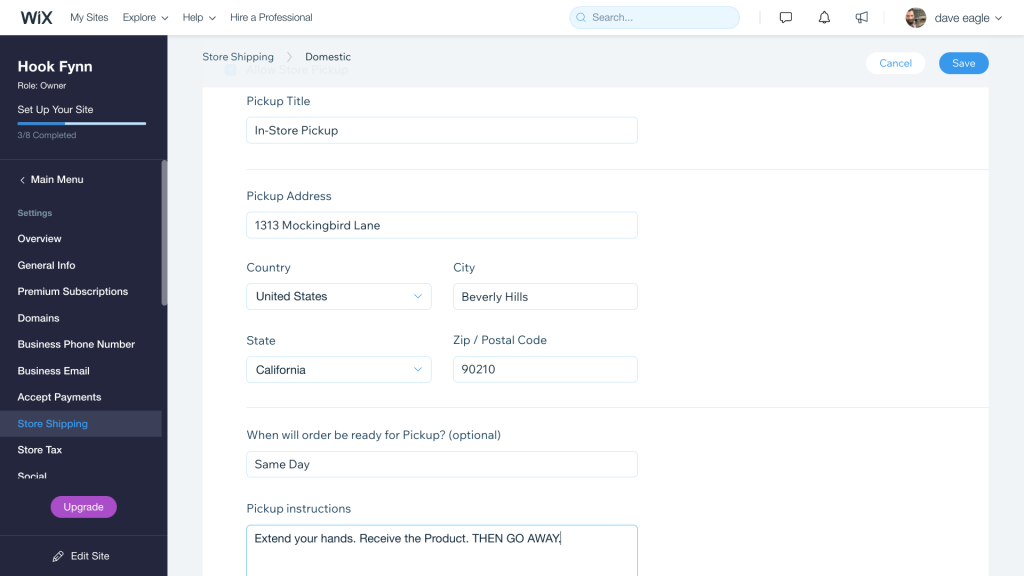
Overview
Wix.com is known more than a Content Management System than an e-commerce platform, but they’ve been making a lot of moves lately to help reshape that perception. The company has a history of growing and adapting with the times: they’ve been around since 2006, starting life as a Flash-based website creation tool. Some time in 2012, Wix users got their final “You must update your version of Flash” pop up message as the company migrated to become a fully HTML5-based platform.
In layman’s terms, this means they started life with what was leading edge technology (Flash), and were smart enough to migrate away from that tech once better options emerged in the market. And they’ve continued on in this vain, adding new tech as necessary, either through development or acquisition and never for a moment sliding into irrelevance. It also makes for a constantly growing, and consistently happy, customer base. 82% of their customers stay with them beyond the first year, which is a true test of customer satisfaction.
Many of the features they’ve added (and the companies they’ve acquired) have been done with an eye toward beefing up their e-commerce offering. Previously, the offering was solid enough to satisfy its predominantly small business customer base, customers for whom ease-of-use is more important than advanced features. Wix aims to change that; in June 2020 they announced some major upgrades to their e-commerce offerings that ought to excite anyone looking to set up an online store easily and affordably: more extensive shipping options, a payments platform, multi-channel sales integrated marketing tools, and web development tools to facilitate developers’ efforts to integrate their own apps with Wix.
Their timing couldn’t be more perfect. E-commerce has consistently grown since the internet first went from a military project to a public assessed commercial network. That growth continues to accelerate, and the global COVID-19 lockdowns have only served to increase the rate of adoption dramatically. Wix’s new e-commerce suite is an answer to what the company’s co-founder and CEO, Avishai Abrahami, referred to as online shopping’s “stage of hyper growth.” His company has seen steady growth over its history, but without these new features they’d run the risk of stagnating or even losing customers. In order for Wix to stay competitive, it needs to ensure its customers do, too. As you’ll see, this new push toward e-commerce seems like a win for everyone—except maybe the companies that are competing with Wix.com.
Pricing
Though Wix is suitable for businesses of all kinds, and they offer eight different subscription plans to choose from. Four of them include e-commerce capabilities, and that’s what we’ll focus on here.
- Business Basic, $23/mo — Retail e-commerce capabilities, unlimited products, abandoned cart recovery, sell on Facebook and Instagram, customer accounts, custom domain, free domain for first year, 20 GB of storage space, 5 hours of video (see Notable Features, below), online bookings, ticket and event management, online ordering for restaurants, reservation system for hotels, sell art and digital content, 24/7 customer care
- Business Unlimited, $27/mo — All of the above, with the following changes and additions: 35 GB storage, 10 hours of video, accept recurring/subscription payments, multiple currencies, automated sales tax for 100 transactions per month (see Integrations, below), advanced shipping, shipping discounts from USPS, third party marketplace integration, up to 250 drop-shipped products, 1,000 consumer reviews
- Business VIP, $49/mo — All of the above, with the following changes and additions: 50 GB storage, unlimited video, Priority customer care, automated tax for 500 transactions per month, unlimited drop-ship products, 3,000 consumer reviews, loyalty program
- Enterprise, Custom pricing — You can choose any or all features you need, customize limits (or go unlimited) on things like storage space, reviews, etc., all while getting VIP support.
Wix’s e-commerce features run the gamut for all business types, and even the Basic plan is impressively stacked with features. Still, a few things need some context, as there’s a little salesmanship going on the feature list. First, nothing here is technically unlimited unless you customize the Enterprise plan to make it that way. Sure, the Basic plan says you can have unlimited products, but you also can’t use more than 20 GB of storage space. Which means there’s a limit. The notion of 24/7 support is fairly misleading, as well. Only the Enterprise plan allows for phone support. Otherwise, you’re submitting tickets through the web or email. Which, you know....you already knew you can access a website or send an email any time of day.
All of the above plans include a $300 ad voucher for marketing your site online: $100 for Google Ads, $100 for local listings, and $100 to flush right down the toilet (or advertise on Bing, your choice).
For any of the e-commerce plans, you can choose to accept credit and debit cards through Wix Payments, or connect your account to one of these payment providers: Braintree, Stripe, Square, and Pinwheel. If you do go with Wix, they offer competitive rates for processing:
- United States — 2.9% of the transaction amount, plus 0.30 USD
- EU Countries — 1.9% of the transaction amount, plus 0.30 EUR
- Switzerland — 2.3% of the transaction amount, plus 0.30 CHF
- United Kingdom — 2.1% of the transaction amount, plus 0.20 GBP
Setting Up Your Store
Wix didn’t start out as an e-commerce software company, but they certainly look like they’ve been doing it forever: the initial setup of the store could not be easier or more thorough. Many of its competitors start you off by having you add products and defining the more mechanical parameters (like payments, shipping, taxes, etc) before getting into the site design. Wix, mirroring its own evolution, starts you off with site design before moving into the e-commerce set up. Ultimately, the order in which these things are accomplished don’t matter in the least. I only bring that up now because these reviews are structured under the assumption that you’re adding products first, and so we look at the store set up before the design aspect. And we’ll continue to do that here.
When you add your first product, you start to gain an appreciation for Wix’s recent push towards improving their e-commerce offering. Setting up your store, starting with products, is dead simple—even if you’re unprepared with images:
Current and former users of WordPress will notice a lot of similarities with image management, including the ability to pull them from stock photo sources directly within the interface. Whether you’re legally sourcing stock images or supplying your own, the process happens as quickly and as obviously as a lie from Donald Trump’s mouth. Every part of adding and defining is easily understood and concisely achieved, and with a fine degree of control. A prime example of precision meshing with simplicity is the way colors variants are created for a product. Allowing for color variants isn’t a new idea, and Wix doesn’t break any new ground by giving you the flexibility to type in whichever colors you’re offering. Where this goes to the next level happens after you type in the color. Add Blue, for example, and a color palette appears allowing you to precisely define and then show exactly what shade of blue you’re offering in your item’s listing.
Apart from variants, you can add the option for customers to personalize the item if you offer that service, quantify inventory, set up custom sections (for return policies, care instructions, whatever you want), or define subscription parameters if that’s what you’re selling. Additionally, you can facilitate the marketing of each item directly from the same screen in which you set it up, with options to edit SEO settings, start an email campaign, share it on social media, along with a few other actions.
After you’ve finished setting up your products and take yourself back to the main dashboard, the Wix interface doesn’t let you out of continuing on with your setup. It still guides you through the remaining steps, including setting up shipping parameters, payment methods, and even nudging you to creating your first blog post to start the content marketing wheel rolling. While Wix was not conceived 15 years ago as a tonic for those seeking an easy on-ramp to e-commerce, this is what it is today. The store set up process with Wix is an example of what software looks like when it does complex things easily and expertly.
Content Management System
Even though CMS has historically been Wix’s bread and butter, it was still kind of a surprise to see how good their design implementation is. Before even getting into the aesthetics of the site, you’re being asked what kinds of features and pages you want to include.
You can choose to create your website’s look one step at a time, or have Wix’s AI create the whole site for you at once. AI-created websites still can’t come close to what an actual designer can accomplish, but with adjusted expectations the feature is pretty helpful nonetheless. It only takes a few minutes to have a full site, with all the navigation and pages laid out, even including paragraphs of relevant, albeit boring, text. The result isn’t necessarily a website you’d want to display to the world, but it is the most custom template you can imagine. It’s a starting point, not an end, but it’s a hell of a starting point.
You could, also, choose from one of more than 500 templates to build your website from the ground up. The editing interface is also one of the best I've seen, not just for e-commerce but as a standalone CMS platform. From the way it highlights each field to note what you’re editing to the site map/menu running down the left side that grounds the user, the whole site creation function of Wix is borderline enjoyable to use.
Notable Features
Wix’s e-commerce offering has pretty much all the features you’d expect from a good quality platform—features like customer accounts, abandoned cart recovery, inventory management—but there are also some less expected things you can do with your store.
- Audio and Video Content — Videos are a cool way to show off any of your products in action, but what if the video were the product itself? With Wix, you can offer, for sale or to rent, original video content for download or streaming.
- Subscriptions — Subscriptions can be sold for digital or physical content, but this feature can also be used to offer real world products as subscription. Whether that’s a monthly box with products, or a staple item that people will want shipped regularly, the subscriptions feature is able to handle the logistics.
- Online Bookings — Allow your customers to book appointments for services of all kinds, as well as classes and seminars. With bookings, you can set aside slots for your own staff, manage multiple calendars, and send automated SMS reminders about upcoming appointments.
- Ticketing — Sell or give away tickets to an event, and operate like a real ticket agency. “Like a real ticket agency” means you’ll be able to dream up ludicrous extra fees and commissions to tack on and pass along to your customers. But you’ll also be able to do helpful things, like creating scannable, mobile tickets for your customers to use for access to the event.
- Social Selling — Sell your products directly from Facebook and Instagram while still being managed and reported on by Wix.
- Pickup and Delivery — In this time of a global pandemic, delivery and pickup aren’t just for restaurants anymore. Local businesses of any kind can provide detailed pickup instructions or just have something delivered directly.

- Email Marketing Campaigns — Integrated email marketing isn’t exactly an uncommon feature for e-commerce platforms, but rarely do they get as automated as this. Use templates to send good-looking emails, and define triggers that determine when they’ll be sent.
- Mobile App — Wix’s mobile is more than just a way to monitor sales and inventory. You can add new products, create coupons, create and publish blog posts, send exclusive offers to customers with accounts, send real time push notifications, and more. You can essentially build and run your store from the app.
Integrations
For as much as Wix can do with its built-in features, the lesson taught by Shopify is that it doesn’t hurt to be endlessly expandable. There’s no app marketplace for Wix like there is for Shopify, but that doesn’t mean you can’t add more features through an integration.
- Avalara — Selling on the internet means your customers could be anywhere in the world, and you may have to charge taxes at rates you don’t know. With the Avalara integration, users get real time automated tax calculation based on the customer’s location and local tax laws.
- Modalyst — With this integration, Wix users don’t even need to have any of their own product/inventory/storage to start selling and shipping things. Modalyst helps users connect with multiple suppliers drop-shipping over 10 million products worldwide.
- KudoBuzz — Wix’s e-commerce platform doesn’t offer consumer reviews as a feature, but this integration with KudoBuzz is probably the next best thing. Social proof is one of the most important marketing tools a small business owner has—especially online, where people might be wary of doing business with a brand they’ve never heard of before. Customers will be able to leave reviews of products, and you’ll also be able to pull in testimonials and other reviews from your social pages to display on your website.
- Smile.io — Loyalty and reward programs are an excellent way to turn first time shoppers into repeat customers. Smile.io takes the idea a couple steps further than the standard “Buy Stuff, Earn Points” model. The tech behind the app also identifies top customers and helps you target them specifically to spread the word about your business for you across social media for the chance to earn more rewards.
- OpenAPI and Development Framework — This isn’t a specific plug in, so much as it’s the mechanism by which any Wix customer can connect their existing systems with custom integrations.
Conclusion
Historically a Content Management System for small business websites, Wix is kind of an underdog in the e-commerce landscape. Hell, even within the CMS world, Wix is kind of an underdog. Of the top one million websites built with hosted builders, Wix has only a .57% market share. Still, their customer base has grown steadily over time, and much more significantly in the last couple of years. 45,000 new users sign up with Wix every day.
Given the recent focus on beefing up their e-commerce offering, and given just how good that offering is, it’s no surprise that their growth rate is accelerating. What is surprising is just how mature their current e-commerce product is, and how broad its appeal is across industries and with companies of all sizes. Small businesses can make use of the many features and plugins and operate like a Fortune 500 company. Fortune500 companies can also benefit from the deep feature stack, and they’ll have the resources to integrate Wix e-commerce into their existing infrastructure. Regardless of business size, all users will find Wix easy to use, without sacrificing any power or functionality.
WIX.com
-
Features
-
Ease of Use
-
Support








